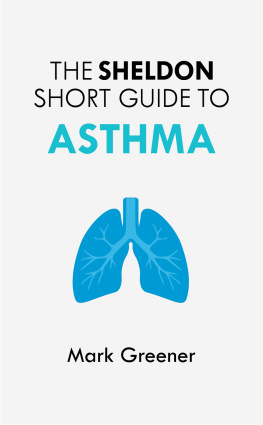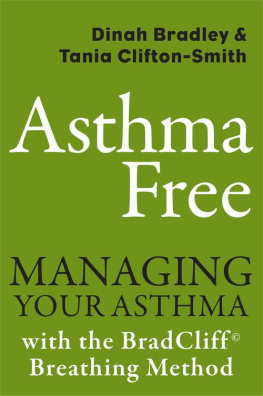Kathryn Shafer, Ph.D., & Fran Greenfield, M.A.
FOREWORD
by Gerald N. Epstein, M.D.
This book is a tribute to two resolute practitioners of mental imagery and mindbody integration who together have fashioned a masterful, innovative, and successful program for the treatment of asthma based on teaching the patient to heal him- or herself.
The credit for this work goes to Dr. Kathryn Shafer, a doctor of clinical social work who came to see me at the age of thirty-five for the treatment of asthma that had plagued her since the age of fifteen months. After two meetings with me she experienced a healing of the asthmatic condition that has remained stable over the past five years in spite of being exposed to the main triggers usually associated with asthma: upper respiratory infection, allergies (she lives in Florida, one of the worst locations in which asthmatics can live), and emotional conflicts. She experienced all three in profusion and weathered them courageously, and without recurrence. Consequently, she decided to become my student and make her practice the very therapy that she used to heal herself. In doing so she has become a wonderful practitioner helping many people to heal themselves.
The merit for fulfilling the gestation of this book goes to Frances Greenfield, a brilliant practitioner of my work, who has built upon it to create innovative treatment programs for prisoners, alcoholics, and cancer patients, showing them how to heal themselves. Fran used Kathys story as a springboard, along with Kathys direct experience and understanding of the asthmatic process, to write this book, which describes the comprehensive mindbody approach that they have tested on their patients with singular success. As in all mindbody therapies, and especially with regard to mental imagery, the patient is empowered and made to be an active participantthe healer in his or her own treatment.
The result of this collaborative effort represents the makings of a breakthrough in the treatment of this devastating disease, currently the leading killer amongst the inner-city population in this country. Asthma has been a riddle for medicine because of the multifaceted dimensions that are so clearly spelled out in the medical literature, yet conventional medical interventions have not significantly stemmed the incidence of this ailment. Also, many patients have been consigned to a state of dependency on the steroids and steroidal inhalants that are frequently prescribed for this condition.
In my breakthrough research in asthma conducted in the mid-1990s under the auspices of the National Institutes of Health, I discovered that by using my mental imagery method, patients were able to stop taking medication altogether, or to substantially reduce it without impairment to their respiratory function. In addition, they were able, in a great majority of cases, to stop using their inhalers.
While my current interests have carried me away from this research, I have felt some measure of gratification that it still lives in the extraordinary development and evolution of that pioneering work, undertaken by these two gifted clinicians. My admiration of them for their fruitful conception and birth of this book is unbounded. Their efforts now open a new door in a new era for a patient-based balanced approach to a psychophysical illness that has eluded the best ministrations that conventional medicine has offered in trying to cure this condition. Kathy and Fran are to be congratulated for bringingpardon the puna breath of fresh air into the treatment of this respiratory malady.
Fear is the lock, and laughter the key to your heart.
C ROSBY, S TILLS AND N ASH , S UITE J UDY B LUE E YES
Without breath, life is impossible. With limited breath, its exhausting and frightening. Yet every day more than seventeen million Americans, almost five million of these children, along with millions of other asthmatics throughout the world, struggle to breathe freely. This natural function of breathing in and breathing out is one that most people take for granted. But for asthma sufferers, too often its a complex, mystifying, and unnerving event.
The disease we call asthma knows no boundaries. It affects people from all walks of life. They come from rural areas, small towns and large cities, all climates and cultures. No two are identical. But the one thing they have in commonattacks of asthma that leave them gasping for breathbinds them together in an immediate and meaningful way.
No longer is this illness an oddity. Asthma ranks sixth out of all diseases as the cause for hospitalization and first in hospital admissions and emergency room visits for children. It invades the lives of the young, the middle-aged, and the elderly; male and female; all racial groups; and every social and economic segment of the population. More than one billion dollars are spent annually on this complicated, life-threatening illness. And day by day its threat increases.
Until recently asthmatics depended on conventional Western medicine for treatment. Yet despite decades of research, the medical model can offer only temporary relief and no real solution. To preclude and suppress symptoms, it advocates the use of bronchodilators, steroids, preventive aids, and pulmonary devices. But little interest has been expressed in natural alternatives, which it considers unproven and ineffective. The light at the end of the tunnel has been obscured by this limited point of view, one that encourages the patient to take a submissive role in the healing process. Such an outlook neglects the premise that asthmatics can do a great deal more than medicate themselves to lessen the severity and the frequency of their attacks.
It is not surprising that asthmatics, who in the past saw themselves as victims, have begun turning to alternative approaches. Our current health care system, based on the authoritarian model of expert and patient, has relentlessly furthered a victim mentality. This results in a sense of helplessness and even embarrassment. In plain words, asthmatics are taught to believe that they should:
1. Hand over all important health care decisions to those experts who are medically knowledgeable
2. Depend on prescribed medications to prevent, address, and suppress symptoms
3. Admit no responsibility for or meaningful relationship to their illness
4. Regard anything other than allopathic medicine as suspect and/or unreliable
5. Be compliant patients and accept asthma as a life sentence
The burgeoning interest in natural remedies and mindbody medicine has generated a new model of healing, one that encourages responsibility for our own well-being and fosters an awareness of the true meaning of health and healing. Health means more than freedom from symptoms of disease. It means being whole. While curing may remove physical symptoms, it provides only superficial relief, leaving the roots of disease untouched. But healing goes much deeper. It involves the integration of mind and bodya unification so seamless we have deleted the usual hyphen from the word mindbody throughout the book to reflect its true meaning.
This is essentially different from the conventional medical viewpoint, which sees the body as a machine, focuses on whats wrong with it, and then tries to fix it as quickly as possible. Instead, this process turns you toward the illness and encourages listening nonjudgmentally to what it may be telling you.









